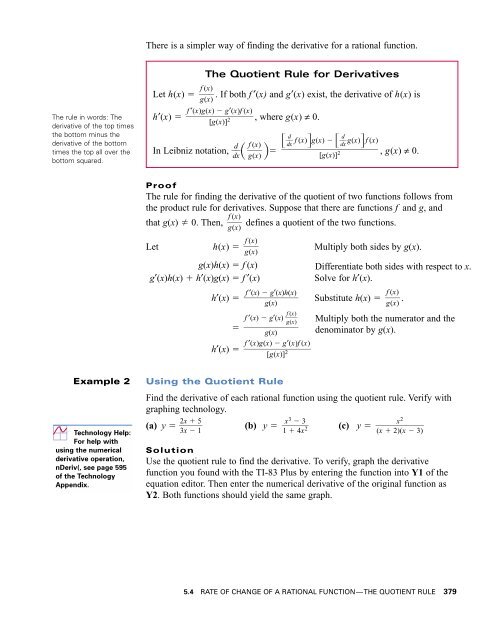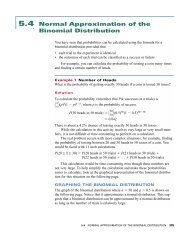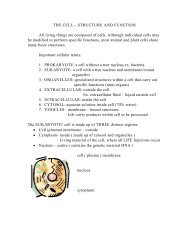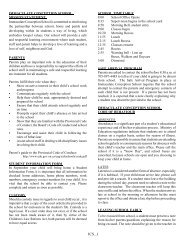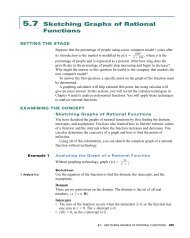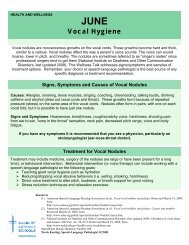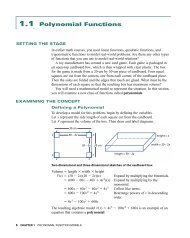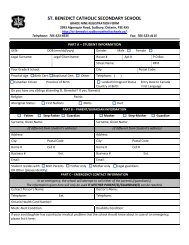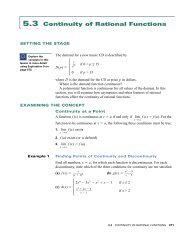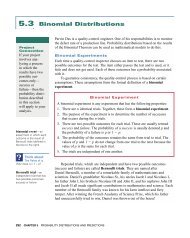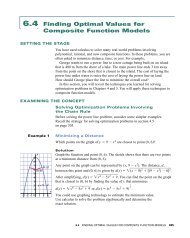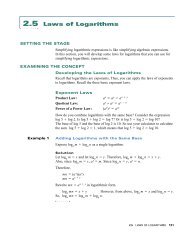5.4 Rate of Change of a Rational FunctionâThe Quotient Rule
5.4 Rate of Change of a Rational FunctionâThe Quotient Rule
5.4 Rate of Change of a Rational FunctionâThe Quotient Rule
Create successful ePaper yourself
Turn your PDF publications into a flip-book with our unique Google optimized e-Paper software.
There is a simpler way <strong>of</strong> finding the derivative for a rational function.<br />
Let h(x) <br />
The <strong>Quotient</strong> <strong>Rule</strong> for Derivatives<br />
f (x)<br />
g(x)<br />
. If both f ′(x) and g′(x) exist, the derivative <strong>of</strong> h(x) is<br />
The rule in words: The<br />
derivative <strong>of</strong> the top times<br />
the bottom minus the<br />
derivative <strong>of</strong> the bottom<br />
times the top all over the<br />
bottom squared.<br />
f ′(x)g(x) g′(x)f (x)<br />
[g(x)]<br />
2<br />
h′(x) , where g(x) ≠ 0.<br />
In Leibniz notation, d<br />
d<br />
x<br />
f (x)<br />
g(x)<br />
d<br />
f<br />
dx<br />
(x) g(x) d<br />
d<br />
g(x) x<br />
f (x)<br />
, g(x) ≠ 0.<br />
[g(x)]<br />
2<br />
Pro<strong>of</strong><br />
The rule for finding the derivative <strong>of</strong> the quotient <strong>of</strong> two functions follows from<br />
the product rule for derivatives. Suppose that there are functions f and g, and<br />
that g(x) 0. Then,<br />
f (x)<br />
g(x)<br />
defines a quotient <strong>of</strong> the two functions.<br />
Let h(x) Multiply both sides by g(x).<br />
g(x)h(x) f (x)<br />
g′(x)h(x) h′(x)g(x) f ′(x)<br />
Differentiate both sides with respect to x.<br />
Solve for h′(x).<br />
h′(x) Substitute h(x) .<br />
<br />
h′(x) <br />
f (x)<br />
g(x)<br />
f ′(x) g′(x)h(x)<br />
g(x)<br />
f ( x)<br />
f ′(x) g′(x) <br />
g ( x)<br />
<br />
g(x)<br />
f ′(x)g(x) g′(x)f (x)<br />
<br />
[g(x)]<br />
2<br />
f (x)<br />
g(x)<br />
Multiply both the numerator and the<br />
denominator by g(x).<br />
Example 2<br />
Technology Help:<br />
For help with<br />
using the numerical<br />
derivative operation,<br />
nDeriv(, see page 595<br />
<strong>of</strong> the Technology<br />
Appendix.<br />
Using the <strong>Quotient</strong> <strong>Rule</strong><br />
Find the derivative <strong>of</strong> each rational function using the quotient rule. Verify with<br />
graphing technology.<br />
(a) y 2 x 5<br />
x<br />
(b) y 3 3<br />
(c) y <br />
3x<br />
1<br />
1 4x<br />
2<br />
x 2<br />
<br />
(x 2)(x 3)<br />
Solution<br />
Use the quotient rule to find the derivative. To verify, graph the derivative<br />
function you found with the TI-83 Plus by entering the function into Y1 <strong>of</strong> the<br />
equation editor. Then enter the numerical derivative <strong>of</strong> the original function as<br />
Y2. Both functions should yield the same graph.<br />
<strong>5.4</strong> RATE OF CHANGE OF A RATIONAL FUNCTION—THE QUOTIENT RULE 379


